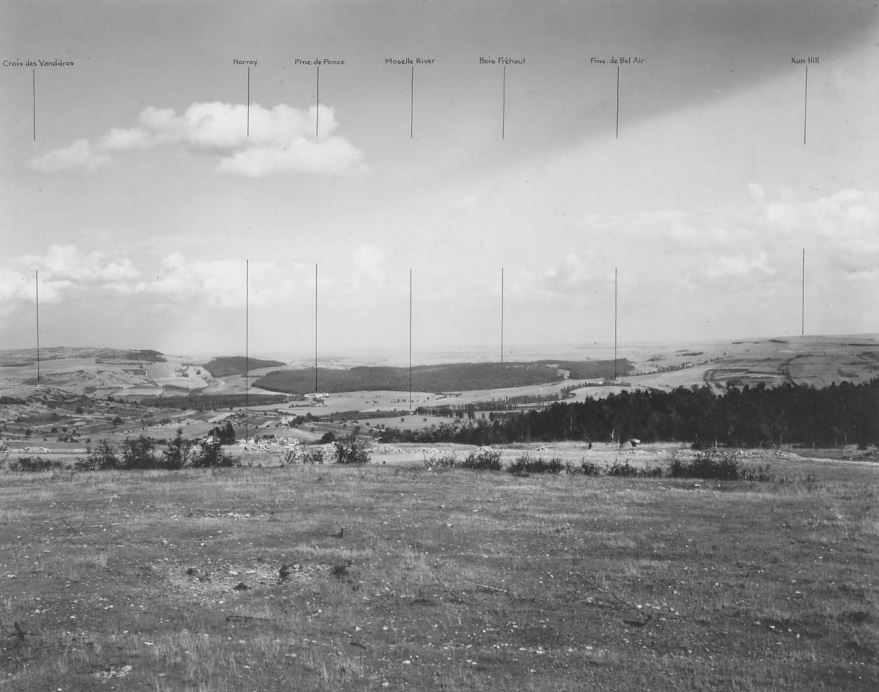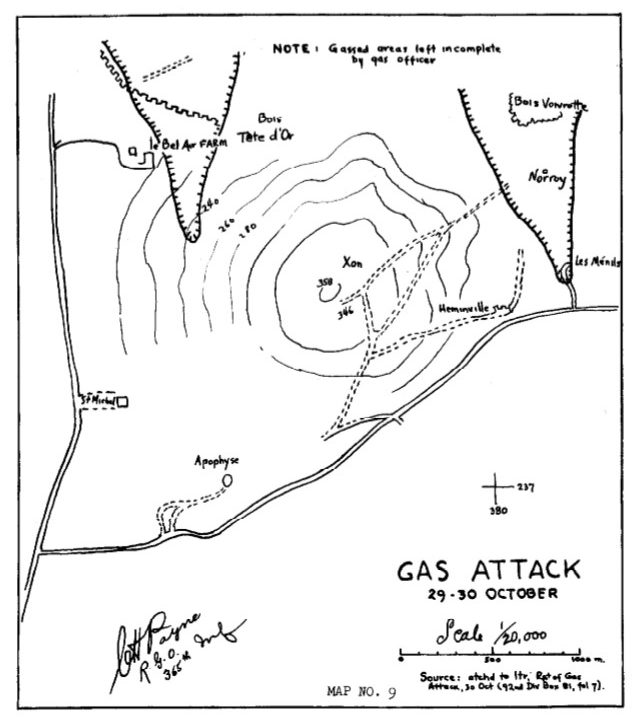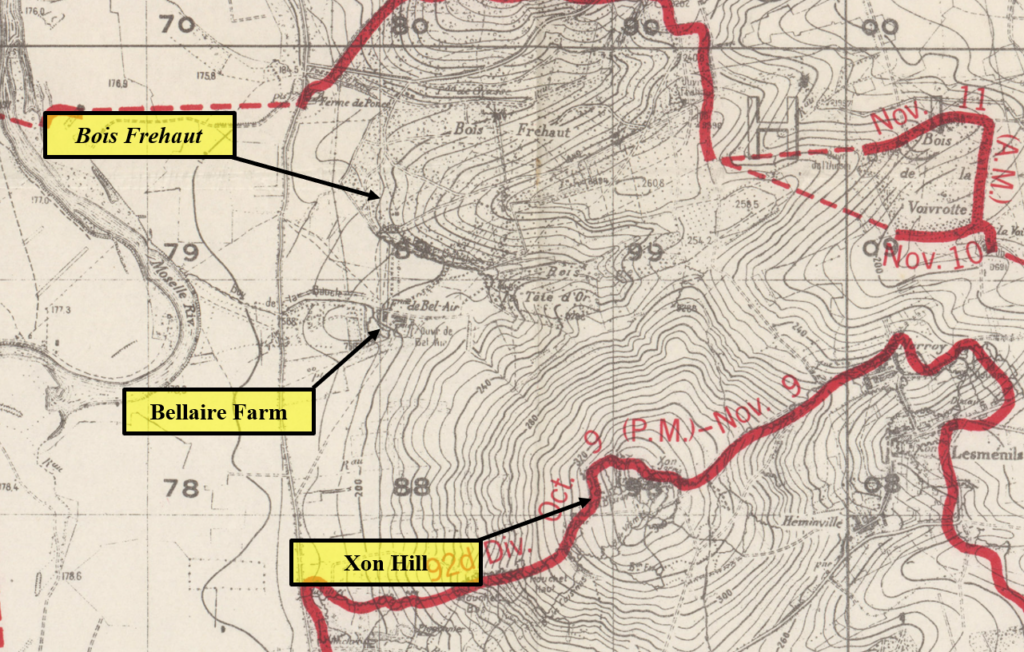Robert M. Breckenridge
Robert M. Breckenridge’s Personal Narrative was derived from information found in public records, military personnel files, and local/state historical association materials. Please note that the Robb Centre never fully closes the book on our servicemembers; as new information becomes available, narratives will be updated to appropriately represent the life story of each veteran.
Please contact the Robb Centre for further clarification or questions regarding content or materials.
Military Honor(s):
Distinguished Service Cross
Citation: The President of the United States of America, authorized by Act of Congress, July 9, 1918, takes pride in presenting the Distinguished Service Cross (Posthumously) to Private First Class Robert M. Breckenridge (ASN: 1967624), United States Army, for extraordinary heroism in action while serving with Company H, 365th Infantry Regiment, 92d Division, A.E.F., at Ferme de Bel-Air, France, 29 October 1918. Although severely wounded in the leg from shell fire, Private Breckenridge, an automatic rifleman, continued in action, crawled forward for a distance of 100 yards to a position where he obtained a better field of fire, and assisted preventing any enemy party from taking a position on the company flank. In spite of his wound, Private Breckenridge continued to use his weapon with great courage and skill until he was killed by enemy machine-gun fire.
Life & Service
- Birth: 20 January 1896, Hennessey, OK, United States
- Place of Residence:
- Race/Ethnicity: African American
- Death: 29 October 1918 Ferme de Bel-Air, France
- Branch: American VI Corps Army
- Military Rank: Private First Class
- Company: [H]
- Infantry Regiment: 365th
- Division: 92nd
Personal Narrative
Robert M. Breckenridge was born to Amilia Cooper Wilson (1877-) on 20 January, 1896, his father was deceased before 1900. Amilia married William Wilson (1878-) and had three children, Verne (1902-1987), Alonzo(1912-), and an unnamed half-sister. A majority of his life story is unknown, including detail of any education or employment positions he held.
Breckenridge enlisted in the U.S. Army on an unknown date; he and the 365th Infantry Regiment left Hoboken, New Jersey on the U.S. Army Transport Ship Agamemnon on 10 June, 1918. Then-Private Breckenridge received the Distinguished Service Cross for his actions near Ferme de Bel-Air, France on 29 October, 1918;
“The Distinguished Service Cross is presented to Robert M. Breckenridge, Private First Class, U.S. Army, for extraordinary heroism in action at Ferme de Bel-Air, France, October 29, 1918. Although severely wounded in the leg from shell fire, Private Breckenridge, an automatic rifleman, continued in action, crawled forward for a distance of 100 yards to a position where he obtained a better field of fire, and assisted preventing any enemy party from taking a position on the company flank. In spite of his wound, Private Breckenridge continued to use his weapon with great courage and skill until he was killed by enemy machine-gun fire”, General Orders No. 31, W.D., 1919.
Private Robert M. Breckenridge served with Company [H], 365th Infantry Regiment, 184th Infantry Brigade, 92nd Infantry Division of the American Expeditionary Force. For his actions at Bellaire Farm on 29 October, 1918, Breckenridge was posthumously awarded the Distinguished Service Cross.
Bellaire Farm – 29 October
October 1918
After they assumed control of the Marbache Sector between the Moselle and Seille Rivers on 9 October, the men of the 92nd Infantry Division proved themselves a tremendous hassle for the Germans opposite their lines. Constant raids, machinegun fire, and, following the delayed arrival of the 167th Artillery Brigade on 18 October, artillery barrages gave the Germans no peace. However, they did not take this beating idly; Gas attacks were common all along the front of the American 2nd Army (92nd Division attached), and many men were wounded or killed in the rolling clouds of Mustard Gas and Diphenylchlorarsine that swept over the trenches, though these attacks were scarcely followed by direct combat.
The German Army was exhausted at this point in the war. In the Spring of 1918, the failure of the Kaiserschlacht to break through the stalemate on the Western Front had left the Germans without the manpower and resources necessary for further offensive operations of any real significance. Additionally, as the Allies’ Meuse-Argonne Offensive continued to gain ground, the German positions in Belgium and Northern France became increasingly untenable. This knowledge, combined with the enemy’s uncharacteristically sheepish disposition, led the Allied commanders to determine that the German gas shoots were likely meant to disrupt any Allied offensives that might turn a fast-approaching general retreat into a total rout. Such an outcome would’ve spelled certain doom for the already crumbling German war effort. Yet, while the end of the war may have been in sight, it was not over yet – On 26 and 27 October, German shells fell like rain onto the American 2nd Army’s lines.
29 October 1918

Taken from the West Bank of the Moselle River, this photograph shows the 92nd Division’s position atop Xon Hill, the German positions in the Bois Frehaut, and the intervening Bellaire Farm.
Following an apparent lull in the German artillery on 28 October, the 365th Infantry Regiment of the 92nd Infantry Division launched a large patrol towards the German-held wooded area composed of the Bois Frehaut, Bois de Voivrotte, and Bois de la Tête d’Or on 29 October. Such patrols were a regular occurrence in this front, as they depleted valuable enemy resources, kept the enemy nervous, and allowed the infantry to get a feel for the enemy’s positions that could prove invaluable when they were inevitably ordered to attack them. Thus, under covering fire from other elements of the 92nd Division atop Xon Hill and on the hilly western bank of the Moselle River, the 2nd and 3rd Battalions, 365th Infantry Regiment set out towards the German lines.

This map shows the areas affected by German Gas on 29-30 October around the 92nd Infantry Division’s sector. Note the Bois Voivrotte and the German trench line near the Bois de la Tête d’Or in the affected areas at the top of the image.
2nd Battalion, including Private Robert M. Breckenridge, made it all the way to the German frontline just north of Bellaire Farm, were a firefight broke out between the German and American soldiers. The two forces would remain in combat in the area between the aforementioned farm and the Bois Frehaut until, suddenly, high-explosive and gas shells began to fall all around them. The raiders from 2nd Battalion were reportedly forced to take shelter in the German’s own trenches for nearly 5 hours. Meanwhile, the accompanying party from 3rd Battalion was likewise pinned in the Bois de Voivrotte far to 2nd Battalion’s right. With both groups pinned-down in enemy territory, concerns that the Germans might attempt to outmaneuver, counterattack, and overwhelm one or both patrols were all-too justified.
Amidst this chaos, shrapnel from a high-explosive shell left Private Breckenridge badly wounded. However, committed to his crucial role as an automatic rifleman, he pushed on and crawled forward 100 yards to a position from which he was able to guard his company’s exposed flank. His weapon’s full-automatic firepower was effective in suppressing the maneuvering German infantry, but the flash and the sound of his weapon drew unwanted attention to the lone infantryman. Though Breckenridge showed remarkable courage and skill in the ensuing firefight, he was sadly killed by a burst from an enemy machine-gun. However, Private Breckenridge’s actions were nonetheless instrumental in protecting his Company from an enemy counterattack, and may very well have saved the lives of many other men from 2nd Battalion.
In recognition of this extraordinary act of heroism, Private Robert M. Breckenridge was posthumously awarded the Distinguished Service Cross in 1919 under General Orders No. 31.
Breckenridge was promoted to Private First Class on an unknown date, most likely Posthumously.
Breckenridge was killed in action on 29 October, 1918 and was buried on October 31 in the American Cemetery at Port-A-Mausson, France; he was then disinterred on 11 May, 1921, and re-buried in the Morrison Cemetery in Hennessey, Kingfisher County, Oklahoma.

